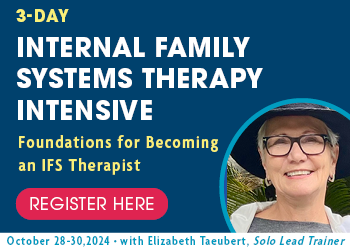Your Roadmap to the 3-Day Internal Family Systems Therapy Intensive
- The basics of IFS: Theory, model, goals and more
- Getting to know the internal system
- Self-Energy: New insights from neuroscience
- How to work with the protective system using the 6 “F’S”
- Clinical demonstration: Observe an IFS session
- Gaining permission: A critical step to working with parts
- Live demonstration: Working with Protectors and using Direct Access
- How to map the internal system
- Three ways of helping a part unblend
DAY 2: The IFS Process of Healing: Working with Exiles and Deep Wounds
- Understanding and working with Exiles
- Managing overwhelm
- The steps to healing in IFS
- Clinical demonstration: Working with polarization
- Live demonstration: Working with therapist parts
- The Power of the therapeutic relationship in IFS
DAY 3: Treating Trauma and Enhancing your IFS Practice with Neuroscience
- The wisdom of the Protective System
- Using a Decision Tree to direct treatment
- Key insights from neuroscience that can strengthen your IFS practice
- The art and science of Unblending
- Clinical Demonstration: Putting it all together
- A neuroscience-informed IFS approach to treating trauma
- Next steps in your training journey
Objectives
- Idenitfy the primary goals of IFS
- Determine how traumatic events can result in the development of internal parts, according to the IFS model.
- Categorize client emotions, memories, thoughts, behaviors and symptoms into the three types of parts described within the IFS model.
- Examine the importance of Self Energy and Self Leadership as they relate to successful IFS treatment.
- List the “6 F’s “ that represent the six steps of working with a part.
- Define the backlash loop that results from moving too quickly when working with protectors.
- Identify target parts with clients using the “mapping “ technique.
- Differentiate how a part is exiled, as articulated in the IFS model.
- Utilize the IFS model to assist clients in identifying the fear of an exiled part.
- Determine how to negotiate with an exiled part to avoid overwhelmed.
- Identify the “8 C’s” that represent the qualities of Self in IFS.
- Determine the six steps of the unburdening process.
- Evaluate the function of polarization and how it may express itself in therapy.
- Evaluate the importance of the therapeutic relationship in the IFS approach.
- Utilize the IFS model’s therapeutic technique of obtaining permission to work with a part for communicating with parts.
- Examine the impact of trauma on the brain and body.
- Summarize how the IFS model can impact the function of the nervous system.
- Determine the process of unblending and the role of memory reconsolidation.


